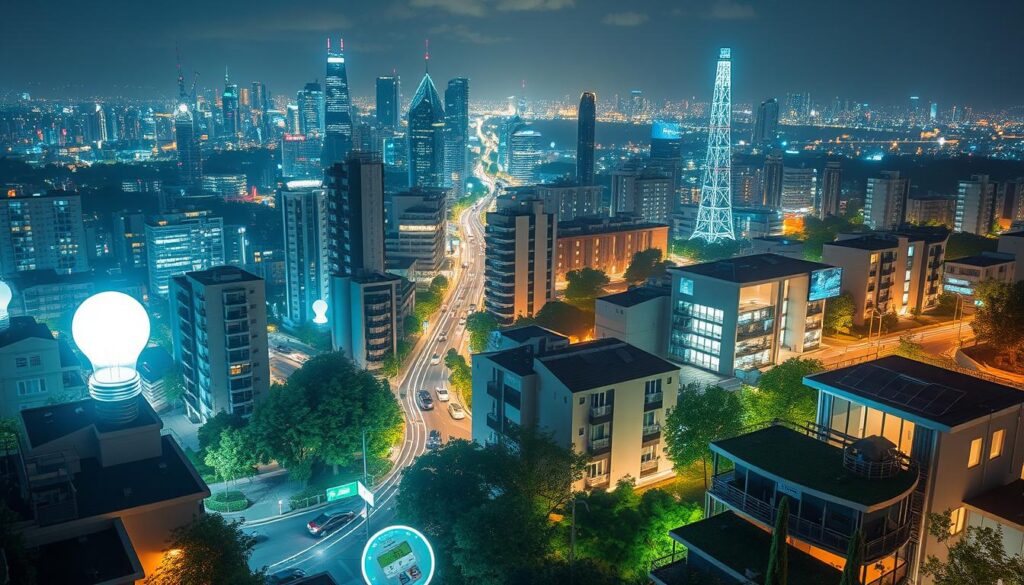The Internet of Things (IoT) is a game-changer for our planet. It’s helping us tackle big environmental problems. This tech is changing how we care for our world, offering new ways to protect it. Let’s look at three key ways IoT is making a difference.
Key Takeaways
- IoT technology is revolutionizing environmental conservation efforts.
- Innovative IoT solutions can contribute to sustainability and eco-friendly initiatives.
- Exploring the intersection of IoT and environmental protection is crucial for a greener future.
- Real-time data collection and analytics enabled by IoT can enhance environmental monitoring and decision-making.
- Integrating IoT into smart city infrastructure promotes urban sustainability and resource efficiency.
Exploring the Potential of IoT for Environmental Conservation
The Internet of Things (IoT) is changing how we protect the environment. It connects technology with nature, leading to a greener future.
IoT’s Role in Promoting Sustainability
IoT devices and sensors are changing how we use and manage resources. They help track energy use and check air and water quality. This way, we can make better choices for a sustainable world.
The Intersection of Technology and Eco-Friendly Solutions
IoT and green tech are creating new ways to protect the environment. Smart cities use IoT to save resources and cut down on waste. Smart farms use IoT to grow more food and use water wisely.
The possibilities of IoT for saving the planet are endless. With data and smart connections, we can create a better future for all.

| IoT Application | Environmental Impact |
|---|---|
| Smart Grids | Improved energy efficiency, reduced carbon emissions |
| Waste Management | Enhanced recycling and waste reduction |
| Air Quality Monitoring | Real-time data for pollution control and mitigation |
3 Ways IoT Could Save the Environment
The Internet of Things (IoT) is changing how we protect the environment. It uses connected devices and real-time data for a greener future. Let’s look at three ways IoT can help the environment.
Energy Efficiency and Optimization
IoT makes homes and buildings use less energy. Smart thermostats adjust the temperature based on who’s home and the weather. This cuts down on energy waste. IoT-driven sustainability also helps in industries, where sensors improve equipment efficiency and lower emissions.
Waste Management and Recycling
IoT is changing how we handle waste. 3 ways IoT can save the environment include smart bins that alert when they’re full. This saves fuel and time. IoT also helps sort recyclables more efficiently.
Environmental Monitoring and Predictive Analytics
IoT for environmental protection means constant monitoring of air and water. It alerts us to environmental problems early. IoT also predicts trends, helping us manage resources better.
As IoT becomes more common in environmental efforts, we’ll see more ways it helps. It’s leading to a cleaner, more sustainable world.
Efficient Energy Management through IoT
The Internet of Things (IoT) is changing how we manage energy. It brings new ways to be more efficient and cut down on harm to the environment. By adding IoT to our energy systems, we open up new possibilities for a greener future.
Smart Grids and Energy Monitoring
IoT is making a big impact on energy management, especially with smart grids. These networks use connected devices and sensors to watch and analyze how much energy we use. They help find where energy is wasted and make it easier to use clean energy sources.
Reducing Energy Waste with IoT
IoT is also key in cutting down energy waste. IoT for energy management lets us control and watch energy use in buildings, factories, and cars. With smart sensors and devices, we can save money and help the planet by using energy more wisely.
| IoT Application | Benefits |
|---|---|
| Smart Grids | Improved energy efficiency, better integration of renewable sources, and reduced greenhouse gas emissions. |
| Energy Monitoring | Detailed insights into energy usage patterns, leading to more informed decision-making and targeted efficiency measures. |
| Waste Reduction | Significant cost savings and a smaller environmental footprint through optimized energy consumption. |
By using IoT for energy management, we can create a future where saving energy and protecting the planet go together. This leads to a greener, more stable world for everyone.

IoT-Enabled Waste Reduction and Recycling
The world faces a big challenge with waste management. The Internet of Things (IoT) offers a solution. It brings new ways to reduce waste and improve recycling.
Smart waste collection is a key use of IoT. Sensors in waste bins track how full they are in real-time. This info helps plan better routes for collection, saving fuel and money.
IoT also helps with recycling optimization. Sensors track recyclable materials, showing how well recycling works. This info helps improve recycling systems and teach people about recycling.
IoT is also great for waste sorting and segregation. Smart bins sort waste automatically. This makes recycling better and reduces landfill waste.
IoT helps communities move towards a greener future. It makes waste reduction and recycling easy for everyone.
Monitoring Air and Water Quality with IoT
The Internet of Things (IoT) is a key player in our quest for a sustainable future. It helps us keep a close eye on air and water quality. This way, we can act quickly to protect our vital resources.
Real-Time Environmental Data Collection
IoT sensors placed around us collect data on air and water quality. They track things like pollutant levels, pH, and temperature. This detailed info helps us understand environmental issues better and find effective solutions.
Predictive Analytics for Environmental Protection
IoT goes beyond just collecting data. It uses advanced analytics to predict environmental problems. This lets us take steps to prevent issues before they happen.
IoT is changing how we monitor our environment. It helps us track air quality in cities and water purity in rivers and oceans. With real-time data and predictive tools, we can make better choices. This leads to a healthier, more sustainable world for all.
IoT and Smart Cities: A Symbiotic Relationship
The world is getting more crowded, and IoT technology is key to making cities better. This partnership between IoT and smart cities is changing urban life for the better. It makes cities more sustainable and improves life for people living there.
Urban Sustainability through IoT Integration
IoT helps solve big problems in cities. It’s all about making cities greener and cleaner. From saving energy to keeping air and water clean, IoT is making a big difference.
- Energy Efficiency: IoT smart grids and energy systems cut down on waste. They also help cities use more renewable energy.
- Waste Management: IoT makes waste collection and recycling better. This reduces harm to the environment and supports a circular economy.
- Environmental Monitoring: IoT sensors track air and water quality in real-time. This helps cities take action to protect their ecosystems.
IoT is helping cities become more sustainable. It tackles big environmental issues and makes cities better places to live. The connection between IoT and smart cities is crucial for a greener, more efficient urban future.
Conclusion
The Internet of Things (IoT) is changing more than just our daily lives. It’s also transforming how we protect the environment. IoT helps us manage energy better, reduce waste, and make cities smarter. It also improves how we monitor air and water quality.
IoT uses real-time data and analytics to solve big environmental problems. It helps us use energy more wisely and recycle more efficiently. This technology is making a real difference in the fight against climate change.
As IoT technology gets better, so will our efforts to save the planet. More people are now aware of the need for sustainability. With IoT leading the way, we’re on track to a greener future for all.
